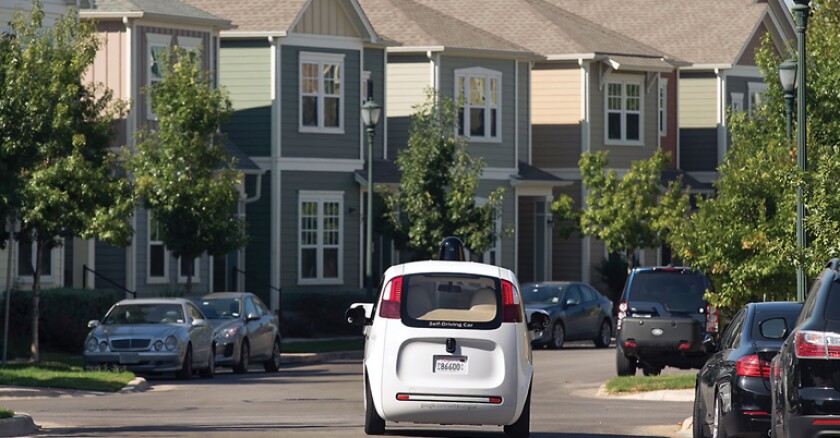Some urban areas, though, make better markets for the new technology than others. Driving conditions, traffic patterns and demographics are just a few of the factors determining how ideal a city is for autonomous vehicles.
A new report from INRIX, a Seattle-based traffic data collection and research firm, offers insight on where the high-tech cars could best be deployed. It’s important, the report emphasizes, for governments in these areas to begin planning for autonomous vehicles to avoid potentially negative consequences down the road.
INRIX analyzed data for the 50 largest cities, comparing two measures: how often trips were less than 10 miles and the percentage of trips starting and ending within a 25-mile radius of a city's downtown.
INRIX selected these measures because autonomous vehicles are expected to predominantly have electric powertrains, meaning they can’t stray too far from charging stations. Many will also operate as shared-use vehicles, so they’ll need to serve areas closer to population centers where seats will be filled.
Unsurprisingly, places INRIX generally found most favorable tend to be less sprawling.
New Orleans, a fairly compact region, was found to be the most practical place for autonomous vehicles based on travel patterns. Earlier this year, the New Orleans Regional Transit Authority conducted a public demonstration of a driverless shuttle bus. “It’s another tool in being able to connect people from where they live to where their jobs are,” says Jeff Hebert, the city’s deputy mayor and chief administrative officer.
Cities determined to be least conducive to autonomous vehicles aren’t necessarily sparsely populated places. San Francisco -- one of the nation’s most densely populated cities -- ranked third from last, and Chicago, another dense city, also registered one of the lowest scores because people there tend to take more trips that are either longer or originate far from downtown.
Numerous other factors not considered in the INRIX report also dictate where autonomous vehicles could be most feasible.
For example, cities with flat landscapes and warm climates might be easier to navigate than those with more hills or inclement weather. Uber chose Pittsburgh as the test site for its autonomous vehicle pilot program in part for this reason. Company officials indicated that the city’s rough driving conditions, which include hilly roads and the occasional blizzard, make for good proving grounds.
Demographics matter, too. Places with more college students, elderly and low-income households without access to vehicles make for ideal markets.
Another place that could be especially prime for autonomous vehicles is Austin, one of the country’s fastest-growing cities. The city's downtown includes the state Capitol, University of Texas campus and central business district -- all requiring short trips. Austin also enjoys a few infrastructure advantages, such as numerous electric vehicle charging stations that are managed by a publicly owned utility.
Robert Spillar, director of the city’s transportation department, foresees fleets of autonomous vehicles potentially filling holes. “We have a robust transit system, but it hasn’t kept pace with the demand and dispersion of trips,” he says. In addition, two of the biggest ride-sharing companies -- Lyft and Uber -- stopped offering service in Austin last year.
Earlier this month, the city council passed a resolution directing the city manager to develop a mobility plan around shared, electric and autonomous vehicle services.
The INRIX report recommends governments in areas best suited for deployment begin planning for autonomous vehicles. INRIX's Avery Ash, who co-authored the report, suggests they could invest in dedicated lanes or identify potential pick up and drop off points, for instance.
“It’s not just a thumbs up or thumbs down for autonomous vehicles but thinking about what areas you want to prioritize for deployment," he says.
Some state and local governments have already taken steps to upgrade infrastructure in anticipation of their arrival. Boston, for one, has partnered with a company that recently started testing self-driving cars in one neighborhood. Ann Arbor, Mich., is experimenting with connected vehicles that can communicate with traffic control devices.
While the introduction of autonomous vehicles may be alluring, it could potentially result in unintended consequences that make traffic problems worse. Many urban planners fear the vehicles could lead people to travel more often or accept longer commutes, further clogging roadways.
Alternatively, with proper planning, autonomous vehicles could evolve in a way that doesn’t stifle urbanization. Under this scenario, commuters would continue utilizing high-capacity modes of transportation and share rides in autonomous vehicles that don't add more cars to roadways.
“There are two visions that collectively everybody says are the two possibilities,” says Austin's Spillar. “I would hope for the more rosy version, but there’s no guarantee that we get there.”
Currently, little research and policy guidance around planning for autonomous vehicles exists. Bloomberg Philanthropies and the Aspen Institute launched an initiative last year aimed at formulating a framework and best practices for governments to follow. The program, which includes 10 international cities, expects to release its first reports later this year.
NOTE: For its analysis, INRIX considered what it calls "highly autonomous vehicles," or HAVs. Some vehicles being tested require occasional intervention by drivers, while driverless cars can operate completely without any human involvement.








